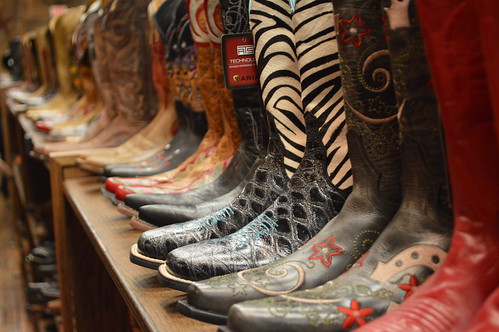
If you search the web for a definition of style, you’ll get mostly fashion tips. A dictionary definition of style doesn’t help much, either:
A manner of doing something.
Merriam-Webster
It seems as of style is such a basic thing that it’s challenging to define.
However, there’s a bit of useful content hiding inside that dictionary definition. It’s the noun: “a manner.”
At its most basic, style is all about the way something is done. The more consistent and clear the “manner” is, the clearer its style. Think about it. How do you know how “western” looks and feels? This image of Monument Valley in Arizona may be close to what you’re thinking.
It’s dusty. Reds and rust oranges prevail. Not much vegetation. Hardly any clouds. But “western” can be communicated by the image of cowboy boots below, as well.
The tips of the boots are pointed or squared off in cowboy fashion. The boots feature stars, horseshoes, stitching and patterns that are rough and bold. These ain’t no European, sleek, modernist boots—they’re bold and tough.
As designers, we make style decisions all the time. We show a client how “modern” looks for a building we are proposing. We choose fabrics and materials to express a certain kind of “comfort” for an interior design proposal. We select a typeface that feels “funky” for a brochure. Sometimes, designing the final outcome is part of our work and other times we just need to create a theme board or mood board to communicate a certain style.
Steven Heller and Louise Fili’s book Stylepedia is a treasure trove of graphic design styles. Terry Wang’s book trailer project animates a few styles that are featured in the book. Can you pick out the different styles and their features?
How to Define Style
It’s possible to be lousy at styling. Don’t be “that guy.” Defining style well requires that you have a clear sense of different styles, their unique details, and can articulate/compile their elements clearly.
For instance, take Tomorrowland at Walt Disney World:
- Pointed spires reaching toward the skies
- Shapes are geometric, mechanical, angled—never organic or “soft”
- Mostly cool colors and white
(I have a beef with the Pizza Port sign. It feels out of character because it looks shows zany bubble letters in a land that’s supposed to be technology-driven. Also, notice the backstage area to the left where the buildings are beige-colored. Not cool. They do not match the style for Tomorrowland.)
Style Beyond the Visual
Sound can present a clear style as well. Think about it—rock music can be all kinds of styles: hard rock, classic rock, psychedelic rock, metal, rock and roll… so many variations of rock. Let’s stick with Tomorrowland and listen to sound styles.
This clip from Space Mountain is energetic, bold, and cinematic.
But this clip from the 1970s makes Space Mountain feel much softer with hopeful sounding flutes accented by a jazzy drumset.
Now Space Mountain sounds all Dr. Who-ey and ominous as it goes electronic with synthesizers.
Take those synthesizers and mix in some 80s flair and you have a Space Mountain that sounds like a remix.
Though all of these clips are Space Mountain, they are very unique styles of Space Mountain.
Be Detailed, Consistent, and Know Your (Style) Stuff
In order to analyze and design styles effectively, you need to do a few things:
- Be Detailed: Every part of the design matters. The style of a salt shaker can throw off the entire style of a restaurant experience. Even salt shakers matter.
- Be Consistent: Everything must work together in a design. In a smartphone app, the writing style, colors, textures, typeface choices, video pacing, sound notifications, and other interface elements must all follow the same style rules in order to be effective.
- Know Your (Style) Stuff: Experience lots of styles and pay attention to them. No matter where you are or what you are doing, you can be researching style. Every style you experience will add to your style-knowledge and repertoire.
References
Heller, S., & Fili, L. (2006). Stylepedia: a guide to graphic design mannerisms, quirks, and conceits. Chronicle Books.


